Coronavirus Today: Getting SMARTER about COVID-19
- Share via
Good evening. I’m Karen Kaplan, and it’s Friday, Feb. 18. Here’s the latest on what’s happening with the coronavirus in California and beyond.
California is about to get SMARTER in the way it confronts the coronavirus.
I didn’t put that in all caps by accident. It’s an acronym for the seven things that will allow us to let down our guard without risking a return to the worst conditions of the pandemic. They are:
Shots
Masks
Awareness
Readiness
Testing
Education
Rx (in other words, drugs to fight COVID-19)
The items on this list are the heart of California’s new blueprint for navigating the next phase of the pandemic, my colleagues Luke Money and Rong-Gong Lin II report.
The 30-page document unveiled Thursday contains lots of specifics. For instance, the state will stockpile 75 million high-quality masks. It will maintain the capacity to administer at least 500,000 coronavirus tests and 200,000 doses of COVID-19 vaccine a day. Officials will keep an eye on the virus’ activities through wastewater surveillance, and it will genetically sequence at least 10% of coronavirus specimens to watch for new variants.
The blueprint acknowledges the uncertainty that comes with the devious virus, which has killed 82,873 Californians and caused nearly 9 million documented infections. The state must be prepared to pivot if cases rise or if hospitals start filling up, it says.
Here’s how things should work in the event of a new outbreak: Positive specimens will be analyzed to see whether they’re an established variant or they represent a new one. If it’s something new, scientists will study it to see whether it’s able to evade vaccine protection or is resistant to treatments. They’ll also investigate how contagious it is and the severity of illnesses it causes. Meanwhile, public health workers will send in test kits and scramble additional medical workers if needed, among other things.
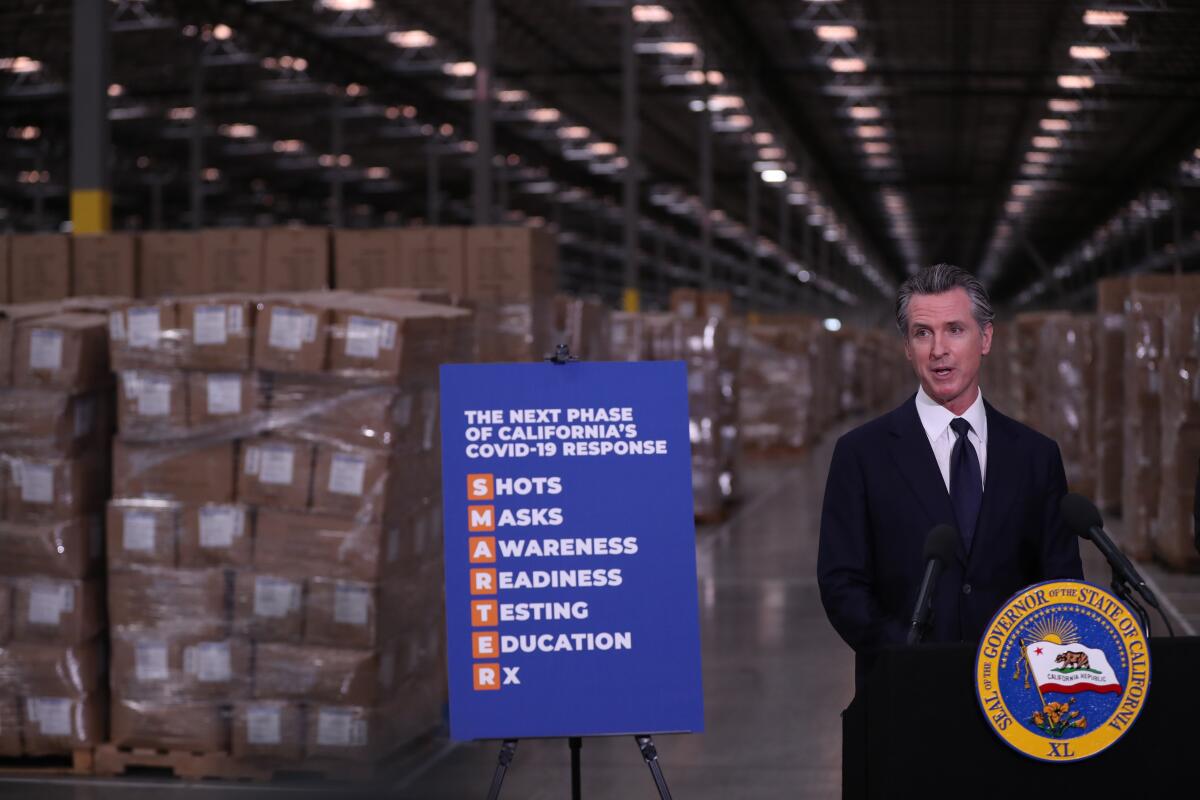
“We have all come to understand what was not understood at the beginning of this crisis: That there is no end date. There is not a moment where we declare victory,” Gov. Gavin Newsom said at a news conference in a Fontana warehouse stocked with emergency supplies. But that doesn’t mean we can’t confidently “move past a constant sense of catastrophe,” as my colleagues put it.
By month’s end, state officials will decide whether to loosen mask rules and other requirements for K-12 schools. Someday, masks will no longer be required on campuses, and when that day comes, it won’t mean that officials have lost confidence in them, said Dr. Mark Ghaly, the state’s Health and Human Services secretary.
“The fact that masks work should not be the debate,” Ghaly said. “There may need to be a time when we all wear masks to get through certain situations, so we don’t overwhelm our healthcare delivery system.”
To that end, California will use a four-tier system to convey how strongly mask use is endorsed for a particular area. In the safest areas, it will be optional. In the next tier up, it will be recommended. Add a little more danger and it will be strongly recommended, and if things got really bad, it’ll be required. (The state is currently in the “strongly recommended” zone.)
The SMARTER approach to the pandemic “is not about moving on but, rather, about moving forward,” Ghaly said. “We aren’t out of the woods. We are just more familiar with the woods and don’t need to live fully afraid of what’s behind the next tree.”
By the numbers
California cases and deaths as of 4:52 p.m. Friday:

Track California’s coronavirus spread and vaccination efforts — including the latest numbers and how they break down — with our graphics.
Learning from our mistakes
Remember back in May 2020, when California’s initial stay-at-home order was eased and businesses were allowed to reopen? It seemed like the pandemic might go down in history as a short-lived period of juggling distance learning with remote work, binge-watching shows on Netflix and becoming very familiar with DoorDash.
If only. The coronavirus took advantage of our ignorance and spread so fast that daily case rates in the state quintupled in a matter of weeks.
Officials responded with the “Blueprint for a Safer Economy.” It placed each California county into one of four risk tiers — purple, red, orange and yellow — depending on factors like the amount of coronavirus transmission and the percentage of tests that come back positive. That system was in place for months, until the economy “reopened” on June 15, 2021.
By then, nearly 63,000 people in the state had died of COVID-19. But vaccines were being rolled out and the virus appeared to be in retreat. Newsom visited the Universal Studios theme park — without a mask — and spoke as if the pandemic’s end were in sight.
“Finally, we are here ... to turn the page, to move beyond capacity limits, to move beyond this color coding, to move beyond social distancing and physical distancing and, yes, as you saw me walk up to the stage, move beyond mask coverings,” said the governor, who was facing a recall at the time.
There was some caution in his celebratory speech — “We’re mindful this disease is not taking today off; it’s not going to take the summer months off,” he said — though most Californians didn’t seem to hear it amid the revelry. Even if cases rose again, the state wasn’t likely to face another outbreak as bad as the devastating fall and winter surge, experts assured.
But vaccination rates stalled. Then the Delta variant arrived, causing infections and deaths to rise again. It was followed by the milder Omicron strain, which was so much more contagious that death rates surpassed those of the Delta wave.
Omicron was the reason for California’s universal indoor mask mandate, which expired Tuesday night. And now that it’s gone, the temptation to act like the pandemic is over has returned.
This time, Newsom and his health advisors are working hard to convey that even though things are looking up, COVID-19 has not gone away, my colleague Taryn Luna reports.
“We have all come to understand what was not understood at the beginning of this crisis,” Newsom said, “that there is no end date, that there is not a moment where we declare victory.”
The hope is that even as mandates fall, people will continue to take voluntary precautions like wearing masks and staying up to date with booster doses.
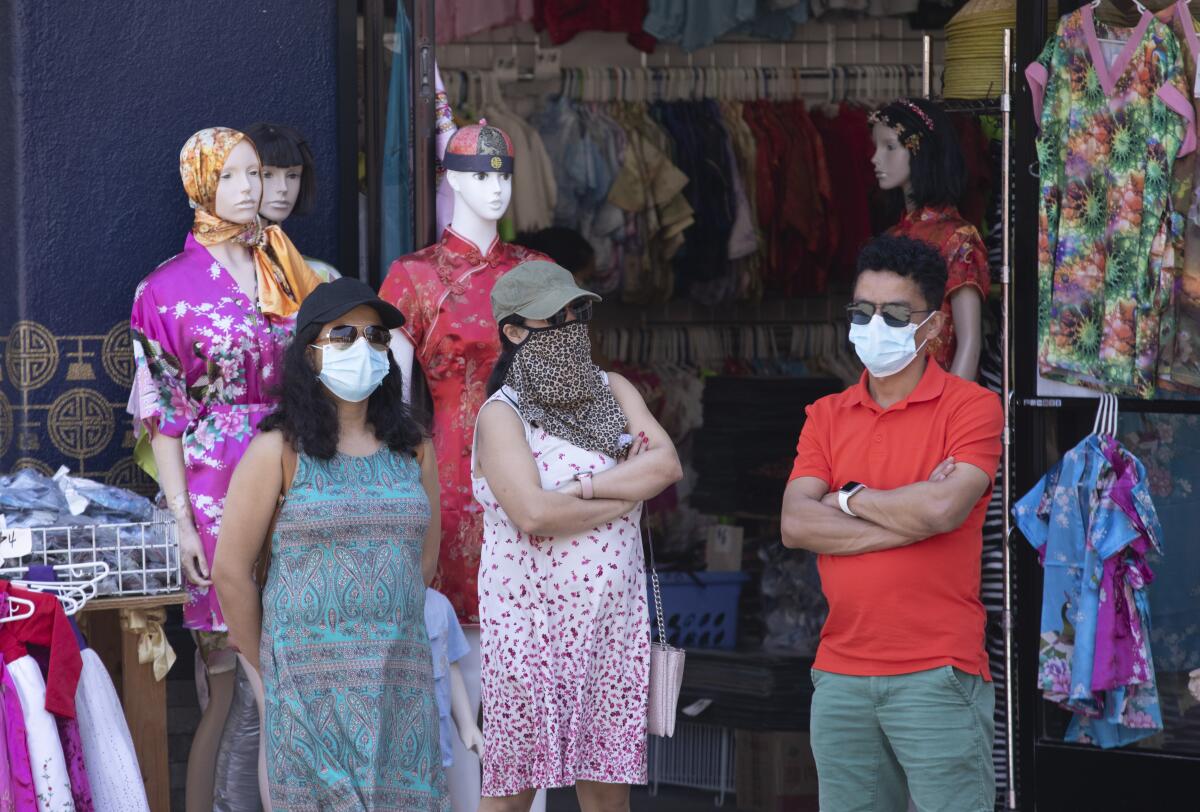
It’s the kind of messaging state Sen. Richard Pan (D-Sacramento) wishes there had been more of on previous occasions when restrictions eased. In particular, he said, officials could have done a better job of normalizing the use of face masks.
If you take Newsom’s message seriously — as you should — you might find yourself thinking like columnist Anita Chabria, who isn’t sure how to behave in a world where “the COVID emergency is over, but COVID-19 isn’t.”
Instead of relying on public health orders to tell her when to wear a mask and when she can safely go without it, she has to make those choices herself. Get ready for the joys of decision fatigue.
Her trepidation is so great that she’s seeing an upside to the partisan fights around COVID-19 rules.
“Tribalism has provided many with some comfort and direction,” Chabria writes. “If you believe in the science and in being a responsible citizen, there was a satisfaction and unity in joining with others who were adhering to the same rules and values.”
California’s vaccination progress
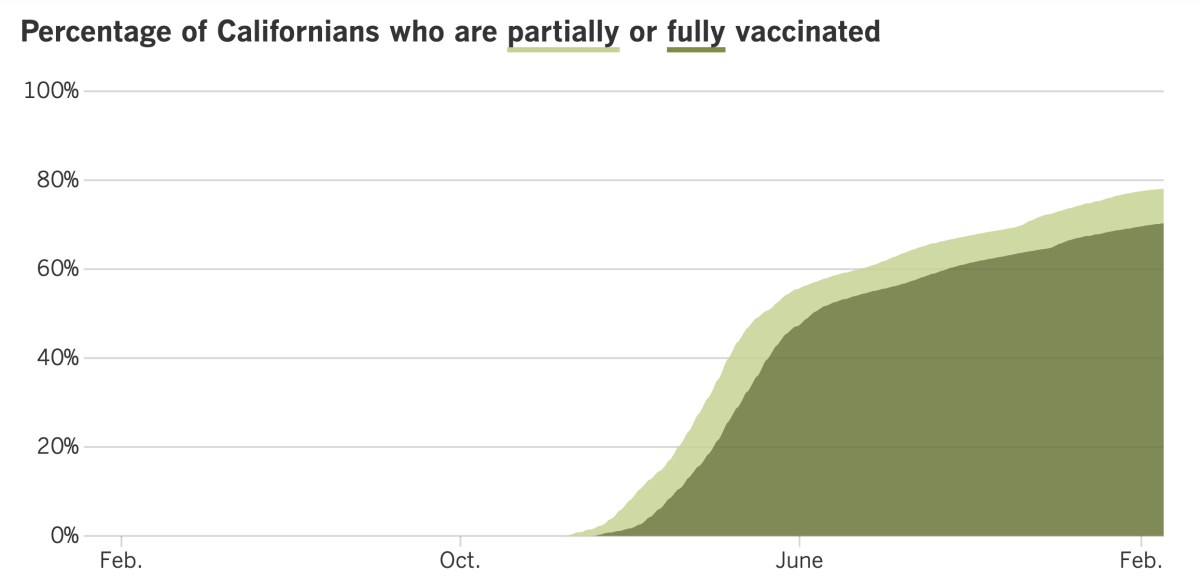
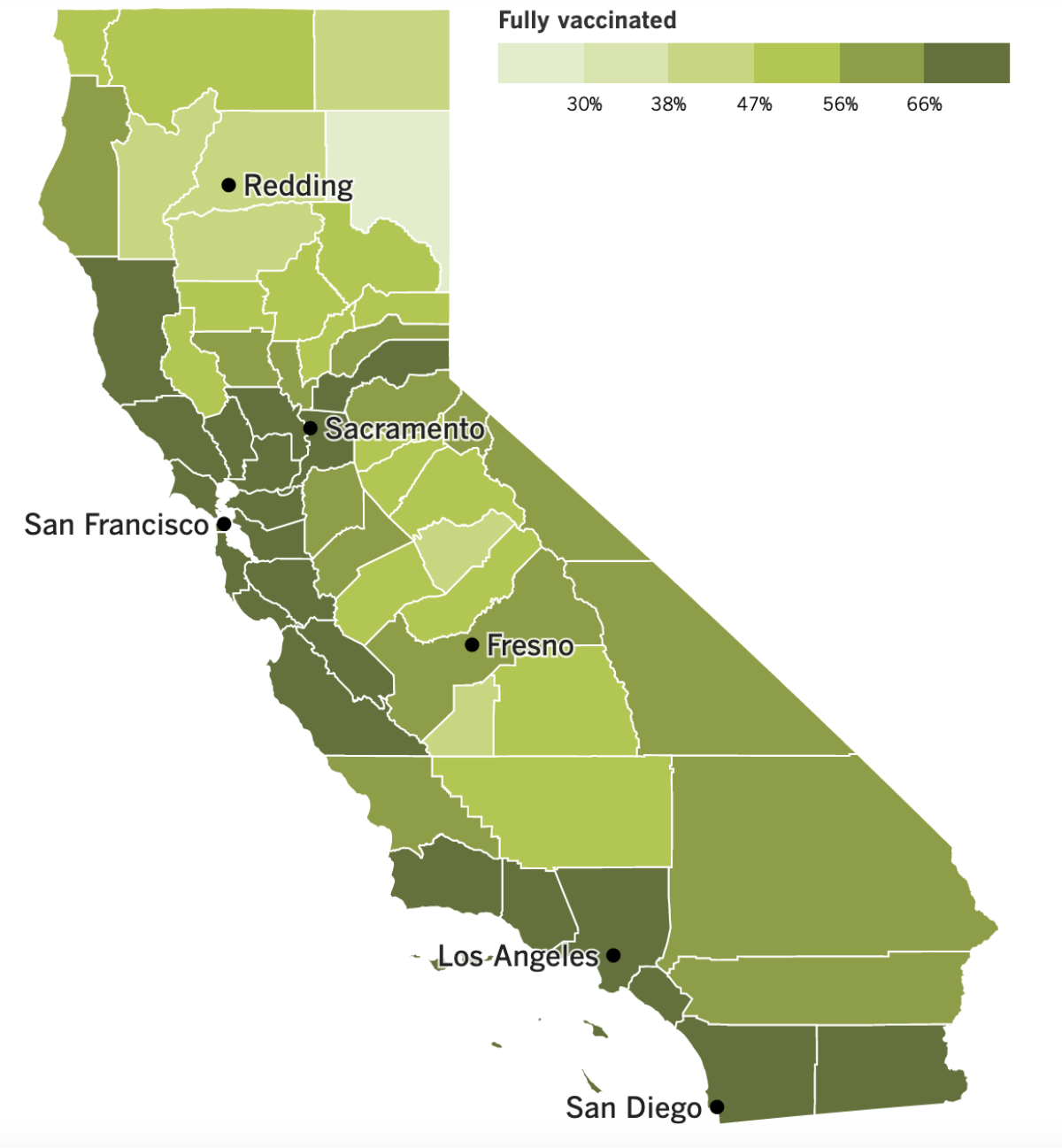
See the latest on California’s vaccination progress with our tracker.
Your support helps us deliver the news that matters most.
In other news ...
Los Angeles County is one of the few places in California where a universal indoor mask mandate remains in place. But it could be gone by the end of March, if not sooner.
Under current guidelines from the Centers for Disease Control and Prevention, masks are advised as long as coronavirus transmission rates are “high” (as they are in L.A.) or “substantial.” Once they fall to “moderate” levels, the county will stop requiring vaccinated people to mask up indoors.
For L.A. County, reaching the “moderate” threshold means seeing fewer than 730 new cases per day for a week. That hasn’t happened since mid-July. Right now, we’re averaging about 4,000 new cases per day over the last week — still high, but an order of magnitude lower than the peak in early January.
“It’s not possible for us to predict future transmission, but we do anticipate that if we have these continued steep declines in cases, which indicate lower transmission, we will be able to safely lift indoor masking mandates in mid-to-late March,” said L.A. County Public Health Director Barbara Ferrer.
Or it could happen sooner if the CDC changes its guidance on face coverings, since L.A.’s rules are aligned with the federal agency’s advice. Dr. Rochelle Walensky, the director, said this week the CDC is reevaluating its mask recommendations and may update them in the coming weeks.
Officials with the Los Angeles Unified School District have reevaluated their mask rules and decided that students may remove their masks while outdoors on campus grounds starting next week. It will be the first time they’ve had the option since the pandemic forced schools to shut down nearly two years ago.
The county allowed school systems to drop their outdoor mask mandates as of Wednesday, but the nation’s second-largest school system took a few extra days to consult medical experts and weigh its options, said Supt. Alberto Carvalho. He added that it was too soon to discuss lifting the district’s indoor mask mandate, which is still required by the county.
In case you need a reminder of why local health officials are being so cautious, here’s one: L.A. County recorded its 30,000th COVID-19 death on Wednesday. It was one of 102 deaths on that day, the second-deadliest of the last 11 months.
In much of the country, COVID-19 rules are falling by the wayside. Offices are reopening, restaurants and bars are dropping their mask rules, and professional sports teams like the Utah Jazz and Washington Wizards aren’t asking fans to show proof of vaccination when they enter the arena.
“We are learning to live with, and mitigate, the impact of the virus on our community,” said Alex Morse, town manager of Provincetown, Mass., one of the first U.S. communities to be hit hard by the Delta variant.
That’s easier to do as immunity spreads. Between vaccinations and infections, about 73% of Americans are primed to fight Omicron, according to one estimate out this week.
Walensky put it nicely during a White House briefing. “We all share the same goal: to get to a point where COVID-19 is no longer disrupting our daily lives, a time when it won’t be a constant crisis — rather something we can prevent, protect against and treat,” she said.
That sentiment is also taking hold in Europe. German leaders unveiled a plan this week to roll back most COVID-19 rules by March 20, as did those in Austria. Switzerland began scrapping nearly all of its restrictions Thursday and the Netherlands followed suit on Friday.
Slovakia’s prime minister said that by the end of February, the country would allow people to visit stores, shopping malls, public gatherings, restaurants and other venues without having to show proof of vaccination or a recent negative coronavirus test. (Israel is putting its vaccine passport system on hold too.)
In France, rules about wearing masks and showing proof of vaccination could be loosened by mid-March. “If the trend continues, the wave could be over in about two weeks,” said Health Minister Olivier Véran. “We could get back to a quasi-normal situation.”
We’ll wrap things up in Canada, where the weeks-long protest by truckers and others may be coming to an end.
A border blockade in Manitoba ended Wednesday after the Royal Canadian Mounted Police said it wouldn’t make arrests if demonstrators departed peacefully. Another blockade at the crossing between Windsor, Ontario, and Detroit wound down over the weekend, though dozens were arrested in the process.
That left Ottawa, where more than 300 trucks were parked in the city center as of Thursday morning. Two leaders of the so-called freedom convoy were arrested later that day, and police sealed off much of the area to thwart additional people from joining the siege.
More arrests came Friday, with officers approaching trucks, campers and other vehicles one by one. Police called in heavy tow trucks to remove the big rigs, and some demonstrators were led away in handcuffs.
“Freedom was never free,” said trucker Kevin Homaund of Montreal. “So what if they put the handcuffs on us and they put us in jail?”
Your questions answered
Today’s question comes from readers who want to know: What’s the difference between pandemic and endemic?
“Endemic” is a word we’ve been hearing more often lately, because it describes what COVID-19 will be like when the pandemic is over.
The disease won’t go away. It won’t stop spreading from person to person or affecting people all over the globe. But when it’s endemic, it will do both of those things at stable — and hopefully much lower — levels than we’re seeing now. That stability will make it possible to contain the disease without the kinds of disruptions we’ve had to live with over the last two years.
Influenza is a good example of an endemic disease. Its behavior is predictable, and the things we do to minimize its impact (like washing our hands and getting a flu shot) don’t interfere with our day-to-day lives.
Typically, an endemic disease causes fewer serious illnesses and deaths than a disease at the heart of a pandemic. For instance, 53,544 Americans died of the flu and pneumonia combined in 2020. That same year, more than 350,000 Americans died of COVID-19, as did more than 475,000 the following year.
We want to hear from you. Email us your coronavirus questions, and we’ll do our best to answer them. Wondering if your question’s already been answered? Check out our archive here.
The pandemic in pictures

The celebration in the photo above looks like a throwback to the Before Times. People are crowded together. There isn’t a mask in sight. No one’s face betrays even a hint of angst.
It’s not from the pre-pandemic era, of course — it was taken just two days ago as fans of the L.A. Rams celebrated the team’s Super Bowl championship.
Thousands of people stood shoulder to shoulder on sidewalks between the Shrine Auditorium and the Coliseum as players rode by in a caravan of double-decker buses. Thousands more formed a sea of blue and gold in Exposition Park and listened as team members took turns at the microphone.
There were no such festivities in 2020, when the Lakers won the NBA Championship and the Dodgers won the World Series a couple of weeks later. For some sports fans, that made the party for the Rams even sweeter.
Coronavirus cases are well below the peak of the Omicron surge but still high enough for public health experts to warn that the parade could be dangerous for those facing a higher risk of developing severe COVID-19. In the coming days, we’ll see whether the coronavirus was out in force on Wednesday along with the fans.
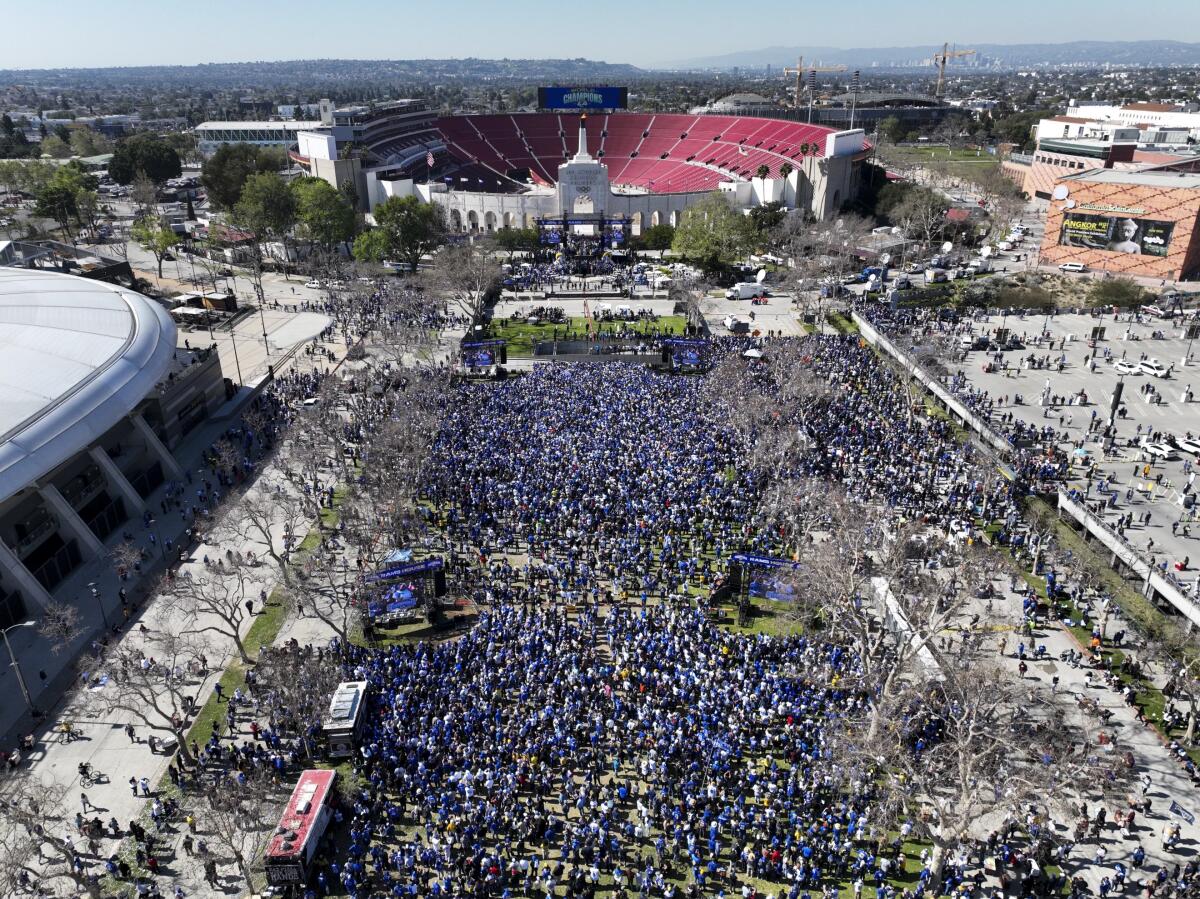
Resources
Need a vaccine? Here’s where to go: City of Los Angeles | Los Angeles County | Kern County | Orange County | Riverside County | San Bernardino County | San Diego County | San Luis Obispo County | Santa Barbara County | Ventura County
Practice social distancing using these tips, and wear a mask or two.
Watch for symptoms such as fever, cough, shortness of breath, chills, shaking with chills, muscle pain, headache, sore throat and loss of taste or smell. Here’s what to look for and when.
Need to get a test? Testing in California is free, and you can find a site online or call (833) 422-4255.
Americans are hurting in many ways. We have advice for helping kids cope, resources for people experiencing domestic abuse and a newsletter to help you make ends meet.
We’ve answered hundreds of readers’ questions. Explore them in our archive here.
For our most up-to-date coverage, visit our homepage and our Health section, get our breaking news alerts, and follow us on Twitter and Instagram.




